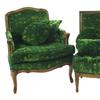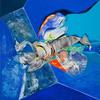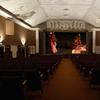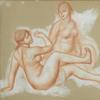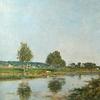Cranbrook Art Museum Presents the U.S. Debut of the Exhibition “Alexander Girard: A Designer’s Universe”
- BLOOMFIELD HILLS, Michigan
- /
- April 17, 2017
This summer, Cranbrook Art Museum will host the U.S. debut of the landmark exhibition Alexander Girard: A Designer’s Universe, the first major retrospective of this former Grosse Pointe resident known for injecting joy and humanism, history and handicraft, into environments that greatly enriched the visual language of mid-century modernism. The exhibition will run from June 17 through October 8, 2017.
While figures such as Charles and Ray Eames, Florence Knoll, Eero Saarinen, Harry Bertoia, Ruth Adler Schnee, and others are considered in the pantheon of mid-century modernism that was birthed in Michigan, Alexander Girard was less well-known but just as influential and important. “Girard is the secret sauce in a new kind of modernism that would emerge at mid-century, a distinctly American one that embraced the handcrafted, the whimsical, the decorative, the colorful — nearly everything that an earlier European modernism tried to banish,” says Andrew Blauvelt, Director of Cranbrook Art Museum.
Alexander Girard (b. 1907, d. 1993) transformed the tableau of post-war American design, from home to office and beyond, by creating opulent worlds in which everything was precisely coordinated, from the smallest details to the larger picture.
“Girard was a modern Renaissance figure, working in nearly every field of design, from textiles and furniture to graphics and architecture,” says Blauvelt. “Girard would champion the total design of what we today call the company's customer experience, from the high-flying style of Braniff Airlines to his groundbreaking design of New York's La Fonda del Sol restaurant. Given Girard’s strong Michigan and Cranbrook connections, it seems fitting that we should shine a light on his prodigious talents.”
Raised in Florence, Italy, and educated in London, Girard came to the United States through New York but settled in Michigan in 1937. He quickly began to form friendships and partnerships with many leading modernist innovators from Cranbrook, including Eero Saarinen and Charles and Ray Eames. In then staid Grosse Pointe, he established a modern design office, gallery, and retail space, and also designed several modern homes in the area, including one for his own family.
He was thrust into national scene when he curated the exhibition For Modern Living at the Detroit Institute of Arts (DIA) in 1949. In it, Girard transformed the museum’s Great Hall, introducing modern design to visitors and journalists with more than 2,000 objects and rooms designed by Charles and Ray Eames, George Nelson, Alvar Aalto, and many more. According to a 1949 bulletin from the DIA, the exhibition, “was one of the most successful ever held at the Institute, attracting more than 150,000 visitors.”
In 1952, Girard became the Director of Design for Herman Miller’s textile division, a post he held for 21 years. While there he innovated the field of textiles for modern furniture and office environments, creating more than 300 textile designs in a multitude of colors, as well as wallpaper, prints, furniture, and objects. According to the company, “through his use of primary colors, concise geometric patterns, and a touch of humor, he injected joy and spontaneity into his designs.” Although he relocated to New Mexico in 1953, Girard kept his ties to Michigan as head the textile and fabric division of Herman Miller, headquartered in Zeeland, Michigan—a major purveyor of modern design worldwide. Herman Miller is one of the presenting sponsors of the exhibition.
This landmark exhibition at Cranbrook presents hundreds of examples of Girard’s work, including furniture, textiles, graphics, architecture, and sculptures, as well as drawings and collages never shown before.
Girard and his wife Susan were avid pioneering collectors of folk art from the world, which they often incorporated into many modern domestic and corporate interiors, and from which he drew inspiration for many of his graphics. So vast were their holdings that it formed the basis of the International Folk Art Museum in Santa Fe, New Mexico. The show also presents numerous folk art objects on loan from the Museum.
For more information about Cranbrook Art Museum, visit www.cranbrookartmuseum.org


